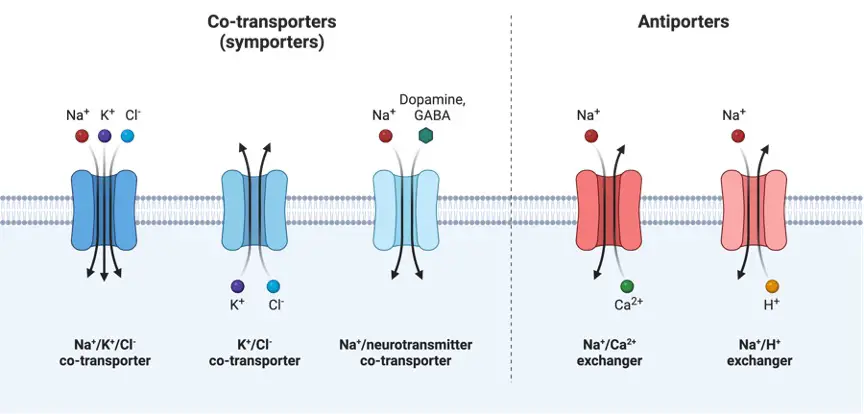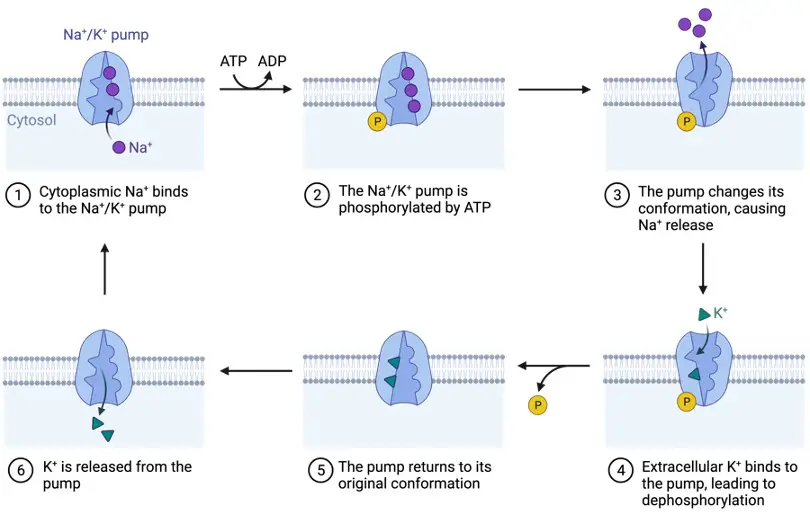Table of Contents
Active Transport Definition
In active transport, substances move across a membrane against a concentration gradient. This means that the direction of flow is from an area of lower concentration to higher concentration. Hence, this process requires energy and membrane proteins (e.g., carrier proteins)
What is Active Transport?
Active transport is a type of cellular transport in which substances ions, glucose, and amino acids) are transported through the biological membrane to an area already rich in these substances. Therefore, active transport uses chemical energy (for example, ATP) to move these substances opposite to their concentration gradient. Active transport commonly occurs in root hair cells on the the wall of the small intestine (villi).
Types of Active Transport
Active transport may be of primary or secondary type. In primary active transport chemical energy is used in the form of ATP whereas in secondary active transport potential energy is used from an electrochemical potential difference. In primary active transport, direct coupling of energy such as ATP is involved.

Substances moved in primary active transport are Na+, K+, Mg2+, and Ca2+. Sodium and potassium pumps are an example of active transport. It is a transport system wherein three Na+ ions are taken outside while two K+ ions are taken inside the cell against their respective concentration gradients.

Another example involves active transport wherein there is protons movement across the inner mitochondrial membrane against a concentration gradient, and it is driven by the redox energy of NADH. During the primary active transport of protons across the thylakoid membrane, photon energy drives the process. This leads to the generation of a proton gradient.
There is no direct ATP coupling involved in secondary active transport. In this transport, the transport is driven by the energy from electrochemical potential difference because the ions are pumped into and out of the cell. In secondary active transport, one ion moves down its electrochemical gradient which results in increased entropy and can be used as a source of energy.
E.g., When Na+ ions move down the electrochemical gradient across the plasma membrane, it drives the transport of a second ion against its gradient, e.g. H+ ions. Such type of transport is also termed coupled transport or cotransport as it involves simultaneous transport of two substances across a biological membrane.
Depending on the direction of movement of the two substances, it may be a symport or antiport. In symport type of coupled transport, both substances move in the same direction. Conversely, if the substances move in opposite directions it is called antiport.
Active Transport vs Passive Transport
Passive transport is another type of cellular transport. It is one of the methods used by cells to move substances across biological membranes. As opposed to active transport, in this case, the substances move along the direction of their concentration gradient.
In active transport, substances (e.g. ions, glucose, and amino acids) move across a membrane against the direction of concentration gradient i.e., from a region of lower concentration to higher concentration. Due to this, cellular energy (e.g. ATP) is used in active transport while passive transport utilizes kinetic and natural energy.
Transporters of Active Transport
In primary active transport, ion pumps, ion channels, and ATPases are the membrane protein transporters. ATPases include are P-type, F-type, and V-type ATPases. Sodium potassium pump, calcium pump, and proton pump are P-type ATPases, F-ATPases include mitochondrial ATP synthase and chloroplast ATP synthase while vacuolar ATPase is V-ATPases. ATP-binding cassette transporters (ABC transporters), For example.
MDR, CFTR, is involved in primary active transport. All of these transporters are ATP-driven. Transporters like antiporters and symporters take part in secondary active transport. Sodium-calcium exchanger which is present in the membranes of cardiac muscle cells is an example of an antiporter. It allows Na+ ions to move into the cell down the concentration and then actively transport one Ca+ ion out of the cell.
The Na+ ions and Ca+ ion movement are in opposite direction. The glucose symporter (SGLT1) is an example of symporter. It found in the internal lining of the small intestine, the brains, the heart, and in nephron. This transporter allows movement of one glucose (or galactose) molecule along with 2 Na+ ions into the cell.
Biological Importance of Active Transport
Active transport is essential in various biological processes. It is employed in various biochemical pathways, for example: chemiosynthesis in mitochondria and proton gradient generation in chloroplasts.
In plants, ABC transporter PhABCG1 helps in active transport of volatile organic compounds across the plasma membrane. This is essential for plants since volatile organic compounds attract pollinators and seed-dispersal organisms.
ABC transporters, particularly NtPDR1, actively transport antimicrobial metabolites in plants. Plants use active transport mechanism when they absorb nutrients from the soil into the vacuole. In humans and animals, active transport is used in many metabolic activities like glucose absorption.
Active Transport Citations
- The structural basis of secondary active transport mechanisms. Biochim Biophys Acta . 2011 Feb;1807(2):167-88.
- The active transport of carbohydrates by Escherichia coli. Ciba Found Symp . 1975;(31):243-69.
- Does active transport exist? J Membr Biol . 1994 Jan;137(2):91-8.
- Figures are created with BioRender.com







